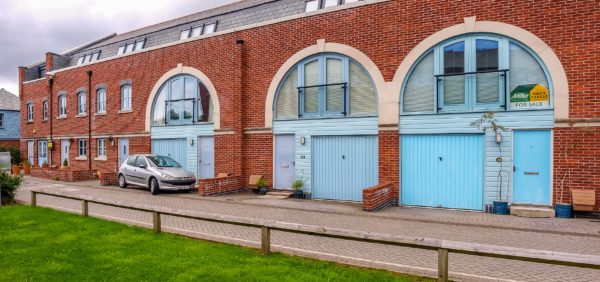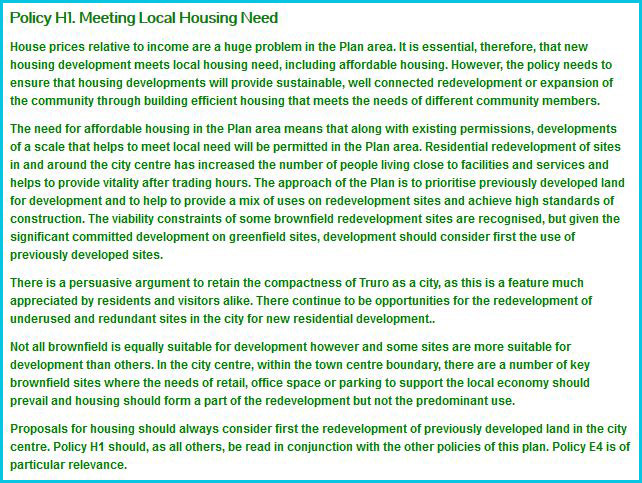Housing in Truro and Kenwyn:
Housing ranges from open market housing, to affordable housing which can either be rented or partly owned. It also includes specialist housing such as sheltered accommodation for elderly or vulnerable people with specific needs.
Truro city experienced its largest modern building waves in the 1960’s, 70’s and 80’s, although steady growth has continued since that time, in Kenwyn. Threemilestone and Shortlanesend both expanded rapidly in the same decades, with the addition of large housing estates. The largest concentration of social housing in Truro is found in estates at Trelander, Malpas, Hendra, Rosedale and Malabar. During the last 10 years, various residential schemes for the elderly have led to an increased population in the city centre, although the majority of residential space above shops is not used as housing, this includes office uses of former houses in Lemon Street, Edward Street and Ferris Town/ St Georges Road.
Providing for new housing involves considering the amount of land required in Truro and Kenwyn on which to build new housing, and the locations where it should be provided. Having access to affordable, quality housing is important for both social and economic well-being. Good quality housing can support and improve job or health prospects, reduce crime, sustain environmental quality and design. Housing delivery can also bring investment and regenerate neighbourhoods.
The Cornwall Local Plan sets a requirement of land to be identified for the building of around 3,900 houses in the period up to 2030. This Plan must provide land for at least this amount, taking into account any need for housing identified above that level. At the time that this Plan was prepared there was need for only a small proportion of that housing to be allocated by the Plan as permissions have already been granted since 2010 for around 4100 dwellings in Truro and Kenwyn.
A non-implementation allowance (a discount rate of 20% to allow for some of those permissions not being delivered before 2030) has been applied to this to allow for houses that may not be started or completed before 2030, but it would still result in the Local Plan requirement being met. The Plan does not therefore make any allocations for housing.
However, due to continued local need for affordable housing and the presence of a number of smaller sites and brownfield land likely to come forward (particularly those in the city centre) for redevelopment during the period of this plan, criteria has been set out to judge further applications for housing against which to meet local needs.
This will help to provide some flexibility if housing developments driven by local need become necessary within the Plan period. The proposals map identifies the Truro centre opportunity sites which we expect may come forward for either mixed use or residential development. These have been identified (but not allocated) to ensure that a brownfield first approach is maintained.
What does the plan propose for housing?
- Sustainability: To make new development as sustainable as it can be. This means increasing density of development where appropriate and making sure that new buildings consume less resources when they are built and into the future through greater energy efficiency and reducing the need to travel.
- Meeting housing needs: policies will require that new development considers fully the mix of sizes, housing types and tenures that are required by our communities to ensure that the housing is the right type in the right location.
- Using previously developed land first: To maintain a compact city and to increase residential presence in the city centre, the reuse of previously developed land must be a priority. This ranges from the reuse of empty accommodation over shops to redevelopment of disused buildings and underused sites.
Not all brownfield is equally suitable for development however and some sites are more suitable for development than others. In the city centre, within the town centre boundary, there are a number of key brownfield sites where the needs of retail, office space or parking to support the local economy should prevail and housing should form a part of the redevelopment but not the predominant use.
Proposals for housing should always consider first the redevelopment of previously developed land in the city centre. Policy H1 should, as all others, be read in conjunction with the other policies of this plan. Policy E4 is of particular relevance
Housing Policies:
H1. Meeting Local Housing Need
Applications for new housing development must help meet local housing need in the Truro and Kenwyn area through the provision of good quality, accessible and environmentally sustainable schemes that meet the needs of our communities.
Developments will only be permitted where they:
Are well integrated by means of scale, location and character with the urban areas of Truro, Threemilestone or Shortlanesend;
Prioritise the redevelopment of previously developed land within the urban areas of Truro, Threemilestone or Shortlanesend; and
Provide a mix of housing in accordance with local needs/demand;
All developments must:
Provide a minimum of 35% affordable housing, phased to be provided alongside the market housing;
Incorporate 5% of self-build or custom build to allow communities to build their own homes, where this would be viable;
Retain and enhance existing habitat and important green space within the site;
Not add to flood risk or result in the loss of flood storage capacity; and
Make a positive contribution to the built environment in terms of scale, materials and bulk.
Where on site provision of affordable housing is not possible, make a financial contribution to off-site provision that is equivalent in value to on-site provision.
Development comprising the redevelopment of open spaces or garden areas will not normally be permitted, unless it can be demonstrated that their loss would not result in visual or recreational detriment to the location or that sufficient space would be retained to mitigate their loss.
H2. Care Facilities
Development of extra care homes to meet the demand of the local older households will be permitted where they:
Are located in a location accessible by good quality, frequent public transport links; and
Prioritise where possible the use of previously developed land within the urban areas of Truro, Threemilestone or Shortlanesend.
Provide capacity for community beds; and
Retain and enhance existing habitat and important green space within the site.
Sustainability
These policies aim to contribute to sustainable development by:
Concentrating new development on brownfield sites or close to public transport and centres of population;
Encouraging the use of sustainable building technology and energy efficiency measures;
Promoting mixed uses (including residential) in accessible locations.
National Planning Policy Framework (NPPF):
NPPF2: Ensuring the vitality of town centres;
NPPF4: Promoting sustainable transport;
NPPF6: Delivering a wide choice of high quality homes;
NPPF7: Requiring good design;
NPPF8: Promoting healthy communities
Cornwall Local Plan:
1: Sustainable development
2: Spatial Strategy
2a: Key targets
6: Housing mix
8: Affordable housing
12: Design
13: Development Standards
21: Best use of land
27: Transport and accessibility
Who will assist with delivering the aims of Housing policy?
Cornwall Council;
Private Sector providers/businesses;
Registered Social Landlords
Land owners and developers.
Voluntary and charity sector







